Shock Value
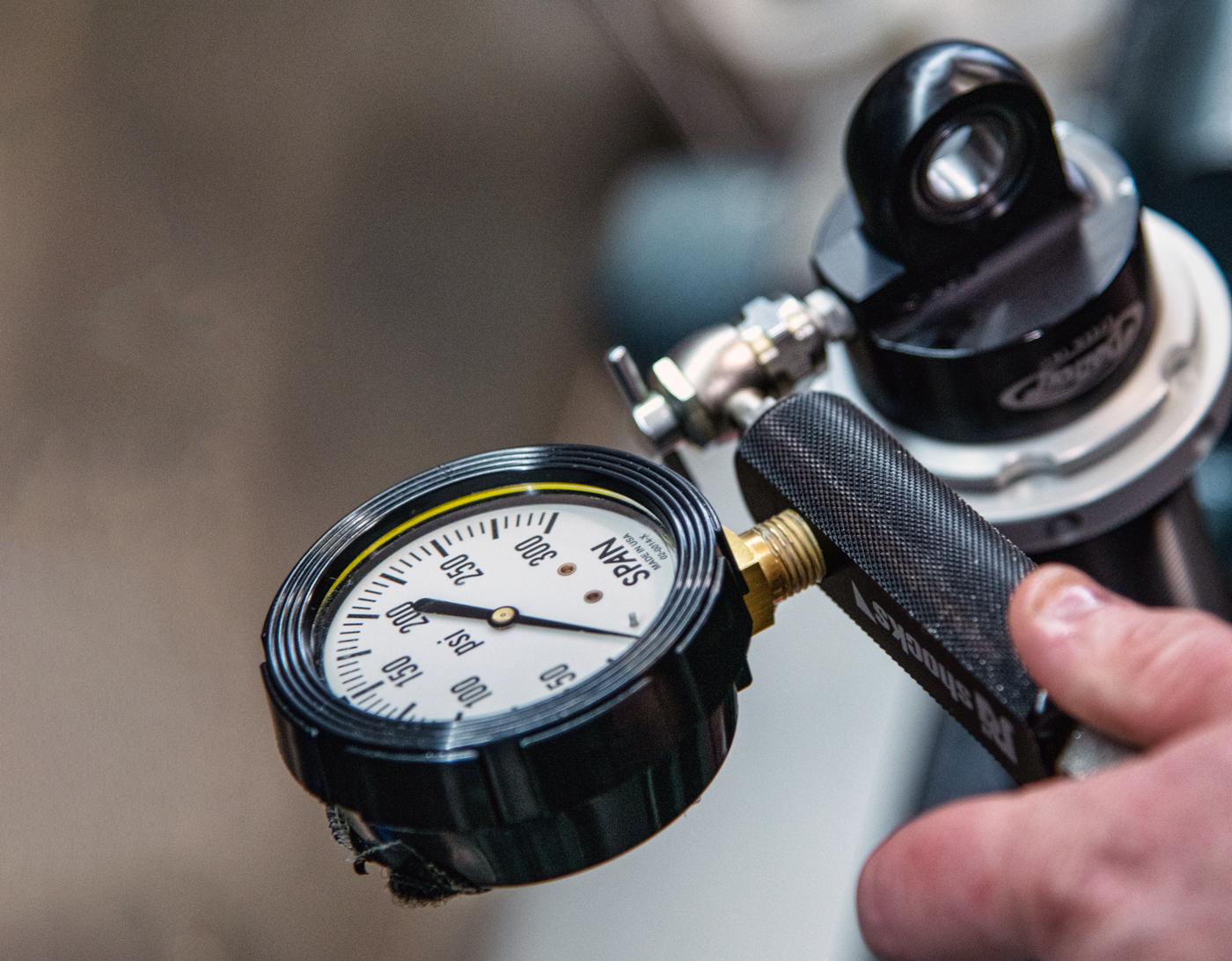
How today’s suspension specialists have become a critical conduit between manufacturers’ product offerings and the exacting setup requirements of top-performing racers.
A winning race team is a relentless machine. The ones standing on the podium have looked under every greasy bolt, every battered panel, and every tangled wire for ways to go faster.
You can bet they’ve put a lot of thought into shock absorbers, or dampers, too. This simple-looking set of tubes can change more aspects of a car than someone might imagine any one component could.
Even so, many racers still don’t think much about shocks. They buy a set of dampers, bolt them in, and then basically forget about them. It’s an unfortunate oversight; effective shock tuning can vastly improve grip, aero, and the overall feel of a car, all of which can translate into significant gains come race day.
That’s why racers of all types increasingly rely on the work of shock specialists to set up shocks and tune them for their exact needs, expectations, and requirements. For many teams, these gurus have become a secret weapon that gives them the edge they need on race day.
The Shock Doctors
Shock specialists are experts at interpreting what racers are trying to do with their cars and then translating that information into the shock absorber setup. For the most part, they’re in the business of taking off-the-shelf aftermarket components and tailoring them to the exact needs of racers to make them faster.
“Manufacturers do a good job building stuff, but their parameters are really wide, because they’re just trying to produce shocks to sell,” said Mike Leary of Leary Racing Products & Shock Shop, Denver, Colorado. “We’re more specific. We can take all day to build a shock, where obviously a manufacturer couldn’t. Our tolerances are really tight. Our stuff is really accurate and repeatable.”
This approach of customizing off-the-shelf aftermarket shocks has led most shock specialists to forge close relationships with manufacturers, fostering a give-and-take sharing of information as needed. “I worked at Penske Racing Shocks for 10 years,” explained JJ Furillo of Ultimate Performance, Concord, North Carolina. “And then after I left, I helped found JRi Shocks. So when I find things that need to be addressed or I see a direction that we need to go, I share that with them.”
“We’ve been working closely with a lot of companies for a long time,” added Angelo Zarra of ANZE Suspension, Jupiter, Florida. “For instance, we were helping Penske in the SCCA ranks in sports car racing. Öhlins came to us and asked if we could help their customers. Then SACHS came to us and asked if we could help their customers, too. So we’ve been working with all the major brands for a long time.”
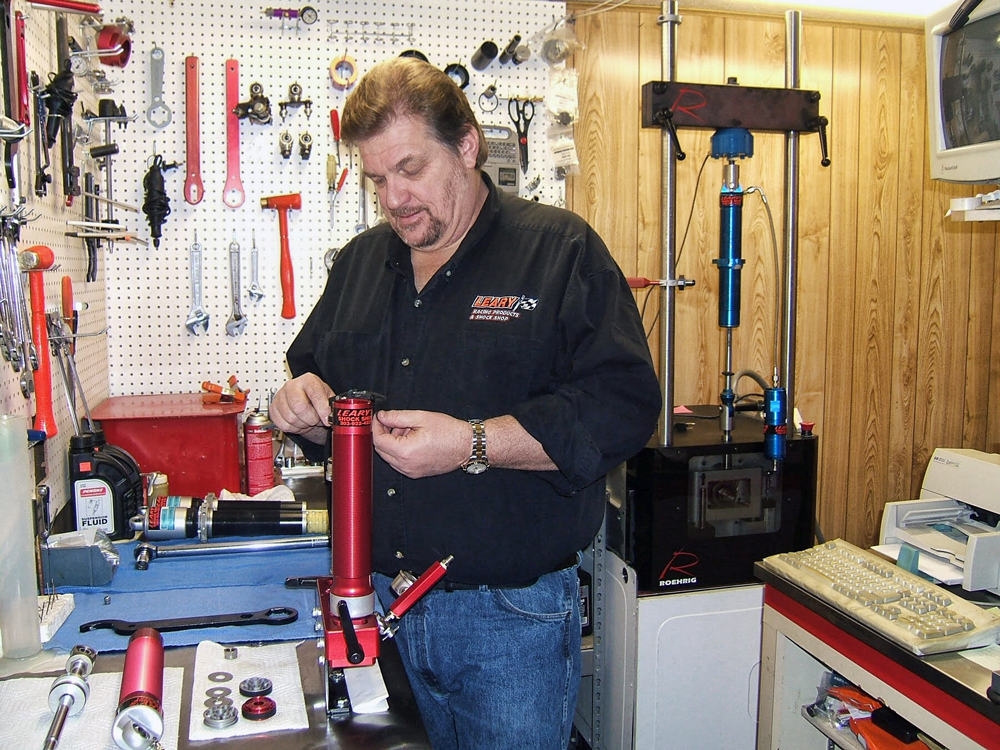
As far as what kinds of cars shock specialists work on, some are more specialized than others. For instance, Furillo of Ultimate Performance focuses entirely on road racing. “If you’re not living a particular world of racing, you can’t keep up with it, and it’s a longer learning curve to figure out what’s needed,” he explained. “The world I live in is road racing.”
Other shock specialists don’t specialize in a particular type of racing, but instead focus on one brand of car, such as TC Kline Racing in Hilliard, Ohio, which is exclusively devoted to BMW cars. This indirectly dictates a relatively narrow range of motorsports for it to work with. “We decided to focus on BMW,” said TC Kline, “and I still feel like that was the right decision, even though pretty much all of our competitors do multiple brands. So road racing, driver schools, autocross, and street is our market.”
In sharp contrast to the tightly focused niches of Ultimate Performance and TC Kline, most shock specialists are highly general in terms of what types of cars and what motorsports they’ll tackle. The prevailing thought among most in the business is that the basic methodology and principles of shock setup are the same no matter what particular surface or type of driving a car is doing. This leads many shock specialists to have a colorful and diverse array of customers at any given time.
“It’s all four patches and a steering wheel,” said Zarra. “So, in the room right now we have Formula Ford, drag racing, Neon, Porsche Cayman Cup, and Aston Martin GT4. That’s where we’re at.”
“We pretty much cover the gamut,” added Leary. “Circle track is my major realm, but we do road racing and a lot of drag racing. And Pikes Peak Hill Climb—we’ve won it nine or 10 times. We even do ice racing.”
For equipment, the shop owners and operators we spoke with primarily rely on Roehrig shock dynos, which can be found doing the bulk of the work at Ultimate Performance, ANZE Suspension, and Leary Racing Products. Since TC Kline Racing uses shock dynos mainly when developing new shock designs, it instead relies on an outside source for its shock dyno work.
Great Expectations
Effective shock tuning can do a lot for a car, but there are limits. All of the experts we spoke with agree that shock work is the icing on the cake—the final tuning of the suspension. “There’s a lot of other suspension tuning that needs to be done before you start changing the shocks,” said Leary. “The shocks finish it up.”
Even the best shock gurus usually can’t make a last-place car into a winner with just shock changes. A lot of it comes down to expectations. “If you’re doing pole-winning times, knocking two seconds off a lap isn’t going to happen,” explained Zarra. “But if you’re running 33rd, putting you in the middle of the field is really possible, if the chassis is sorted and we’ve got good bones to work with.”
That’s not to say that good shock tuning can’t sometimes have dramatic results. Although shock specialists tend to think of their work as complementing an already effective suspension setup, there are times when nothing more than a shock change has indeed transformed a car and brought radically better results.
“I had a drag racing customer come in, and we improved his 60-foot time by two-tenths—night and day,” recounted Leary. “And I have had some road racers bring shocks in, and they pick up a second or two over the whole course.”
“During my career in NASCAR, I was approached by a team before a race at Dover,” added Furillo. “They considered themselves junk. I built them a set of shocks, and along with a host of other changes, they won the race. That’s just one example, but it happens.”
As tightly focused of a niche as shock tuning is, the work can sometimes spiral out to incorporate almost all aspects of a car. Shock specialists often make recommendations on practically any part of the suspension. “A good shock specialist understands the entire dynamics of the car,” said Furillo. “What the car wants or what the driver is looking for isn’t always a shock adjustment. It could be a spring change. Or it could be a sway bar change. Knowing that and moving forward with those changes is what makes a good shock specialist.”
“My customers get a lot of information from me, because I’ve been racing my whole life,” added Leary. “Not only can I help them with shocks, but I can help them with spring and sway bar selections and some suspension settings.”
This big-picture approach may even include a car’s aerodynamics. Although most racers think of shock changes for strictly handling and overall-feel improvements, shocks can also make significant changes in a car’s aero. “We can run enough shock that we can hold the attitude of the car where it needs to be,” said Furillo. “That can sometimes help to get around certain aero rules.”
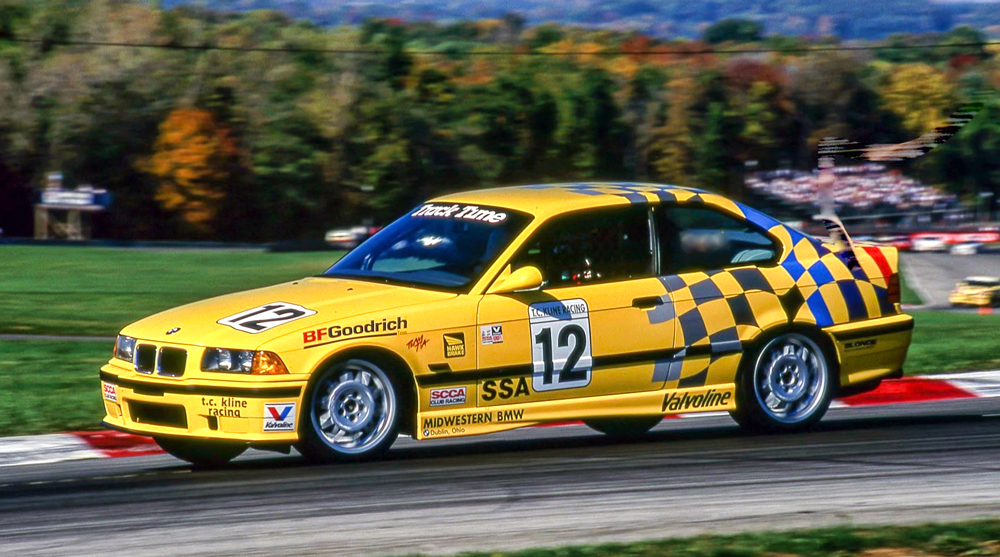
Even with the many potential advantages to be gained with effective shock tuning, getting those great final results may not be as direct as racers might expect. In some cases, shock experts analyze what a car is doing and recommend addressing other aspects of the car before even attempting to set up the shocks.
“It’s not always just the shocks,” noted Zarra. “For example, we just won the Pan American Nationals in drag racing. That process started years and years ago. We built a set of shocks for the guy, and he sent me a video. I said, ‘Look at how the rear wheel ratchets—it winds and unwinds. That’s not shocks. You’ve got a driveline issue.’ So he fixed that and some other things, and then ‘boom’—championship.”
No matter what underlying issues shock specialists have to deal with to get a particular car where it needs to be, the primary measuring stick for success is how the car feels for the driver. This is both the starting point and the end goal for shock specialists.
“For most really good drivers, feel correlates to speed,” said Zarra. “If the driver is comfortable, he’s going to be fast. We call that confidence-inspired grip. At a subconscious level, the driver says, ‘I keep asking for more, and it just keeps giving it to me.’”
That said, there are times when the best-feeling setup for a car isn’t the fastest around the track. This is relatively rare, according to our experts, but it does happen. Many times, such mismatches are rooted in the experience and skill of the racer.
“Racers form habits, and they know what they like,” explained Leary. “But that may not always be the fastest way. Actually, young drivers are usually easier for us to work with—they don’t know what the car should feel like. They get in the car and think, ‘Okay, this is what it’s supposed to be like,’ and they drive it.”
A lot of it comes down to learning each driver’s preferences over time and knowing how to serve those needs best. “It’s easier if you’ve worked with a driver for a period of time to really zero in on what they need,” noted Furillo. “Because you have a relationship with them, you know what they’re looking for, and the communication is good. When it’s somebody new, you have to say, ‘Here’s a good starting point, then we can progress from there on how to fine-tune that to your needs.’”
Getting to Know You
When starting that relationship, first, lay some groundwork. Racers need to begin by looking at their cars closely and making sure everything is correct to begin with. If there are misaligned pieces, worn components, or damaged structure, the work of a shock specialist will, at best, be a bandage on those problems.
Chances are, the shock specialist won’t even want to begin the process until these other issues are addressed. “I want to know about the chassis setup,” said Zarra. “Is it pitched? Is it tilted? Is it bent? Is it welded crooked? Is it cracked in half? Has it been rolled over 17 times?”
After carefully inspecting the car, then it’s time to gather plenty of information about the current setup. Generally, the more detail a racer can provide, the better. Along with that, videos can offer valuable insight as well.
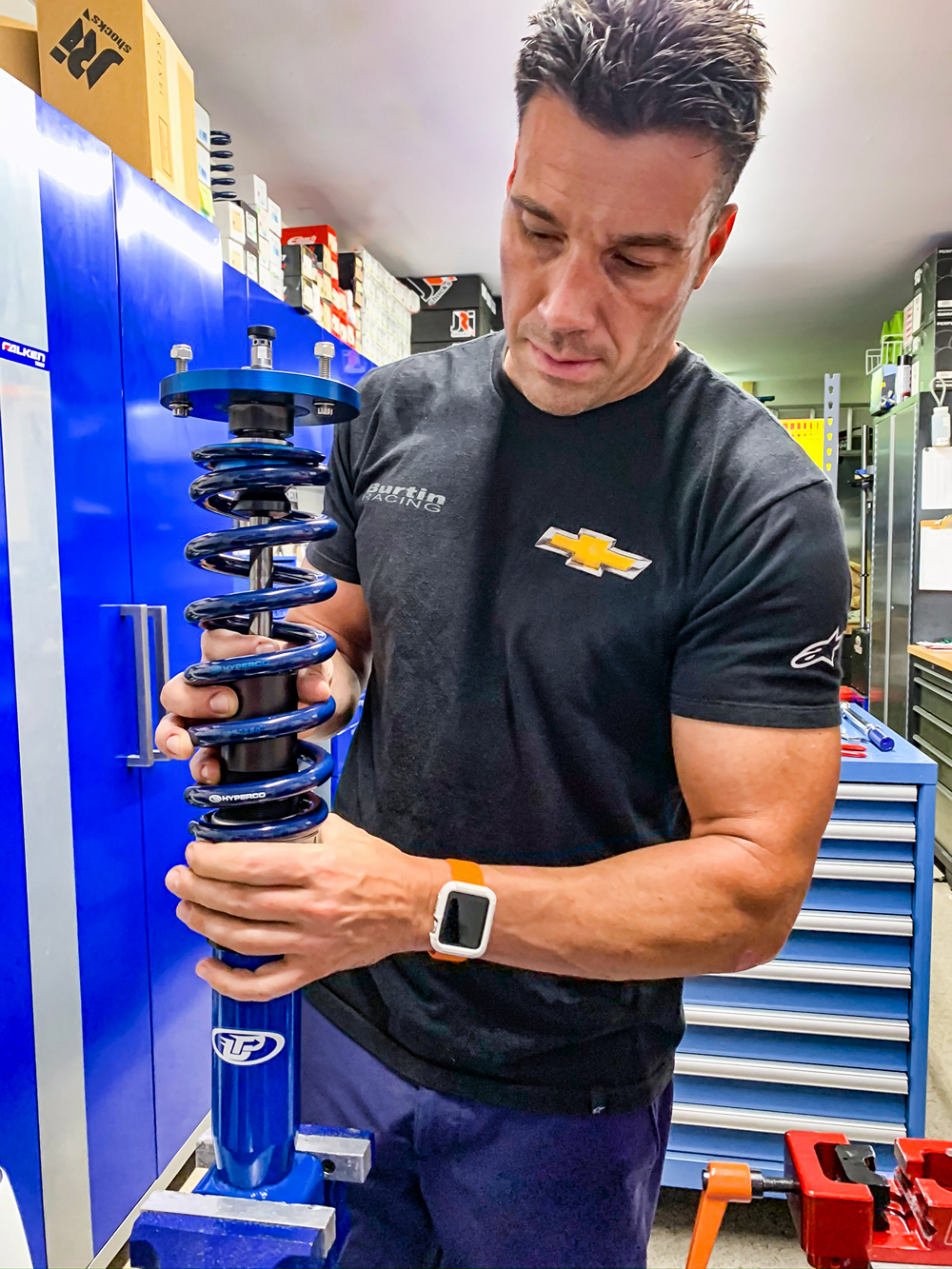
“The more feedback we get, the more areas we can dive into,” explained Zarra. “It starts with the basics. What’s your ride height? What’s your corner weights? If you can go deeper, what’s your motion ratio, and wheel rate?
“And videos, too,” continued Zarra. “Inside videos are good—we get to see the steering wheel and the driver. But boy, sometimes outside video is amazing. I just got three videos yesterday of a front-drive drag car. So I can watch it in slow motion and see how the car squats, rotates, and what it does. So just through simple video analysis and driver feedback, we can get a pretty decent idea of what’s happening.”
Next, customers need to think about what they’re feeling when they drive their cars, and what they’re dissatisfied with. This is obviously subjective. They need to discuss their preferences with the shock specialist, who can properly customize to their requests. This often requires a nuanced conversation between the driver and the shock specialist. Good shock specialists are experts at getting to the heart of what drivers are really feeling.
“A lot of times I’ll ask the same question to the driver three different ways to make sure that’s exactly what he’s feeling,” said Furillo. “Because sometimes, what they’re describing as the problem is just the end result—the actual problem is somewhere else. For example, the big thing we hear is the driver saying, ‘I’m loose off.’ Okay, well, we can try to fix that. But more than likely, the problem is happening at the corner entry to the middle of the corner.”
In these conversations, racers need to be completely open and honest about what they’re actually trying to do—how often they plan to race, what resources they have from week to week, and what level of success they’re aiming for. “Every driver, every race mechanic, every team needs to admit what they’re really after,” said Zarra. “Maybe that’s, ‘Hey, we’re going to run four races a year, and we’re going to try to zing it up front and beat the factory teams.’ And then I can say, ‘In only four races? All right. It’s going to be tough, but we’ll try to get you there.”
Armed with information like this, shock specialists will work to provide the optimum initial setup for a car, with an eye toward the team’s long-term goals and the available resources. Along with that initial setup, shock specialists typically provide guidelines for ongoing changes.
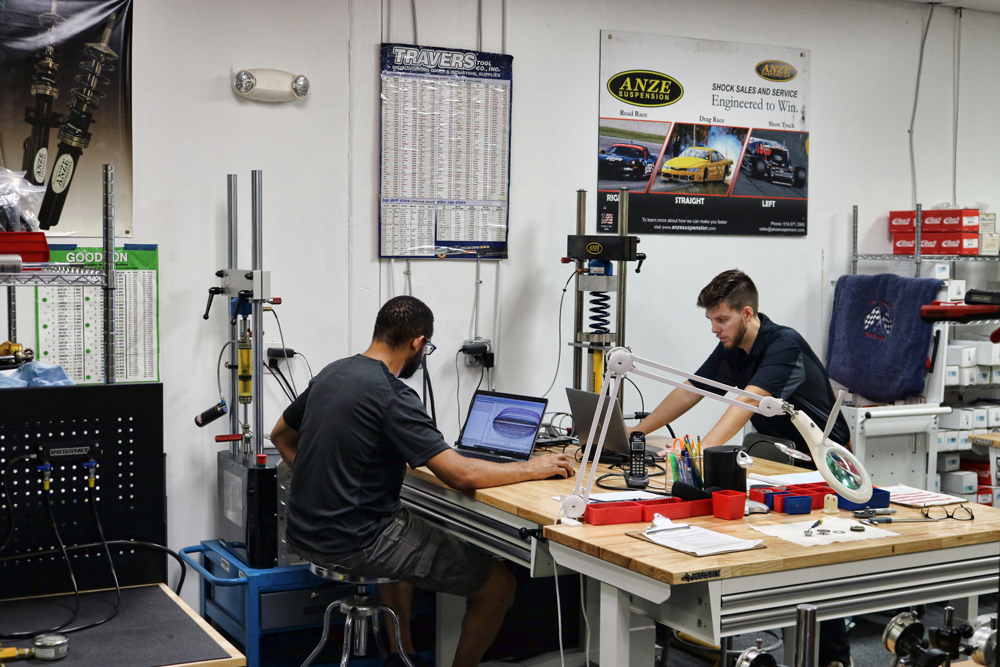
“We always include a setup sheet with our shocks,” noted Kline. “If you follow our guidelines, you’re going to be within 2% of optimal all the time. So you can fine-tune once you get used to driving the car with our setup, and you’re very familiar and comfortable with it.”
No matter how well a shock specialist sets up the shocks, remember, nothing stays the same forever. Rules, technology, and tracks can vary wildly over time. The initial work with a shock specialist will likely be the first contact in an ongoing relationship.
“This isn’t set-it-and-forget-it type stuff,” said Furillo. “Setups change, aerodynamic packages change, tires change, brake packages change. As one thing changes, it’s very much a chain event. It impacts other parts of the car. So we need to keep up with that. We continue to evolve to try to make things better.”
Even if rules and setups are relatively stable for a particular type of racing, shocks still need ongoing maintenance. Many racers bolt in new shocks and forget about them, but like anything else on a car, the performance of shocks degrades. Sometimes the change is so gradual racers don’t notice.
“Think about if every time you take the car out, it’s 1% less crisp,” said Zarra. “If you do 21 track days, imagine being 21% worse on horsepower. Now, with shocks, it’s not necessarily that number, but you get the idea. It creeps up on you.”
What’s more, like other parts of a car, neglecting shocks can make them harder to save when the customer finally brings them in for work. It’s likely to be far more cost-effective in the long run to take care of the shocks during the season rather than neglecting them until they’re unsalvageable.
“If you think about it, when do you change the oil in your engine?” asked Zarra. “When you shove a rod through the block? When the pistons are scored? It’s your choice. We’re budget-minded, but when you send in dampers that haven’t been serviced in 15 years, there’s only so much we can do. Stuff we serviced just last year is fairly crisp, everything’s good, the service goes easier, and the parts bill is less.”
How often should racers have their shocks serviced? The experts we talked to said shocks should come in for service at least once a season. But they quickly pointed out that this is a very general minimum. The ideal interval for servicing shocks can vary greatly.
“Shocks need to be serviced at least every year,” explained Zarra. “How do you know if the sealed black tube on the corner works or not? You send it across the dyno. Every championship we’ve ever won, the shocks came back here for revalving and tuning two or three times within the year.”
“It depends on what’s actually going on,” added Furillo. “In some series, shocks may run 10 or 12 races, so you can get away with doing it once a year. But even that depends. If you’re a Saturday-night racer and you race 25-lap main events, your rebuild isn’t the same as the guy running 100-lap main events.”
With the help of shock specialists, racers can see big gains in all aspects of a car. No, these experts generally can’t transform a struggling back marker into a podium star. But they could very well be the elixir that elevates a race car that little bit extra from good to great.
In the process, customers almost certainly end up with cars they enjoy driving more. That is, after all, one of the key aims of shock tuning—to make the driver feel good behind the wheel. Doing so almost always translates to better on-track performance.
“When the car handles really well, you’re buried in the throttle all the time,” said Kline. “And that’s the essence of our focus—your ability to use power with total confidence.”
Sources
ANZE Suspension
anzesuspension.com
Leary Racing Products & Shock Shop
learyracingproducts.com
TC Kline Racing
tcklineracing.com
Ultimate Performance
upspeedshop.com
 MEMBERSHIP LOGIN
MEMBERSHIP LOGIN JOIN PRI
JOIN PRI


